一年级上册英语教案 Good morning 牛津译林
- 格式:doc
- 大小:34.50 KB
- 文档页数:10
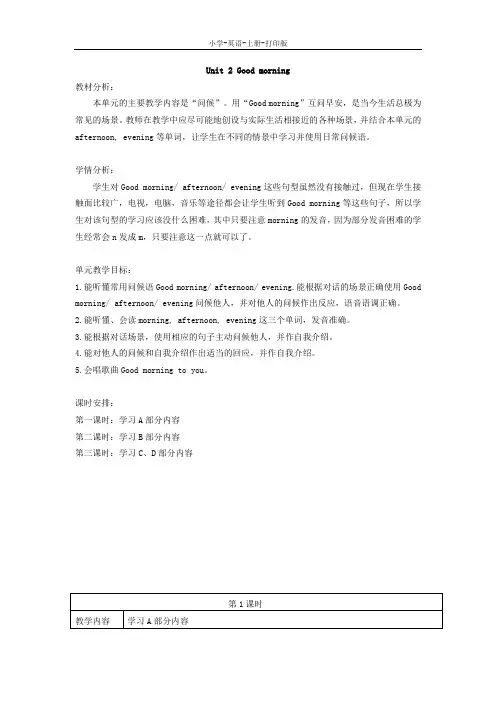
Unit 2 Good morning
教材分析:
本单元的主要教学内容是“问候”。
用“Good morning”互问早安,是当今生活总极为常见的场景。
教师在教学中应尽可能地创设与实际生活相接近的各种场景,并结合本单元的afternoon, evening等单词,让学生在不同的情景中学习并使用日常问候语。
学情分析:
学生对Good morning/ afternoon/ evening这些句型虽然没有接触过,但现在学生接触面比较广,电视,电脑,音乐等途径都会让学生听到Good morning等这些句子,所以学生对该句型的学习应该没什么困难,其中只要注意morning的发音,因为部分发音困难的学生经常会n发成m,只要注意这一点就可以了。
单元教学目标:
1.能听懂常用问候语Good morning/ afternoon/ evening.能根据对话的场景正确使用Good morning/ afternoon/ evening问候他人,并对他人的问候作出反应,语音语调正确。
2.能听懂、会读morning, afternoon, evening这三个单词,发音准确。
3.能根据对话场景,使用相应的句子主动问候他人,并作自我介绍。
4.能对他人的问候和自我介绍作出适当的回应,并作自我介绍。
5.会唱歌曲Good morning to you。
课时安排:
第一课时:学习A部分内容
第二课时:学习B部分内容
第三课时:学习C、D部分内容。
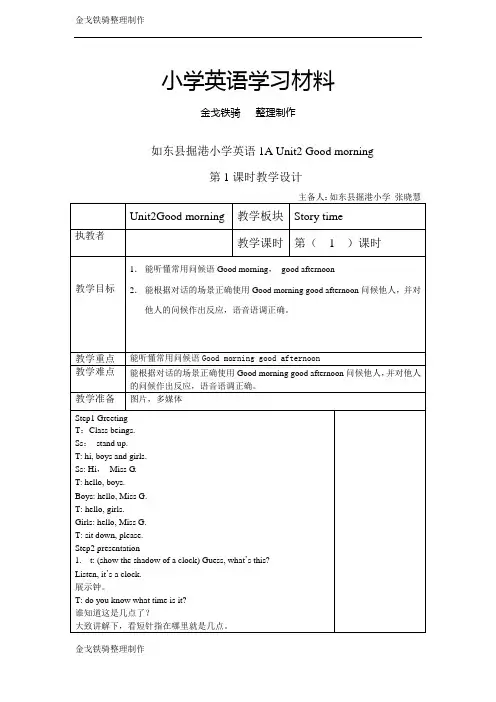
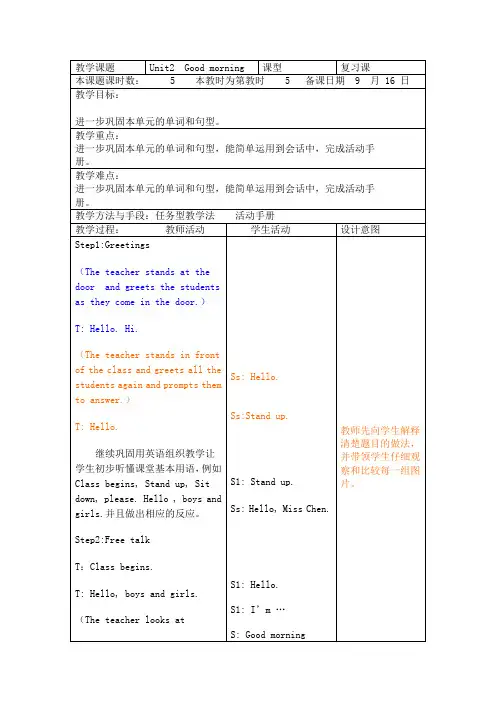
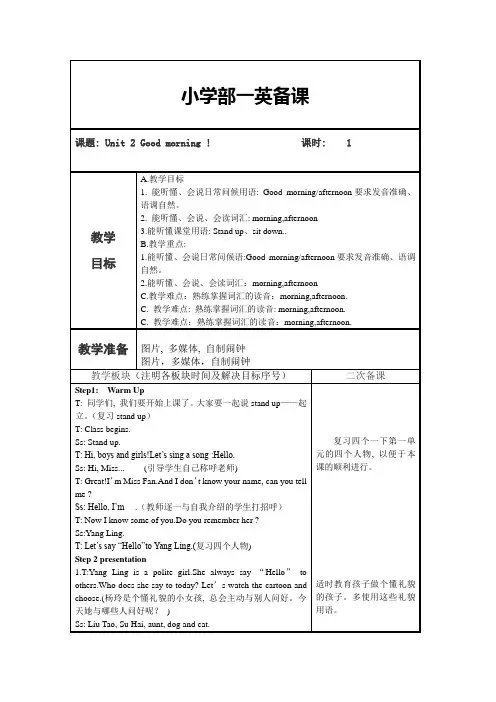
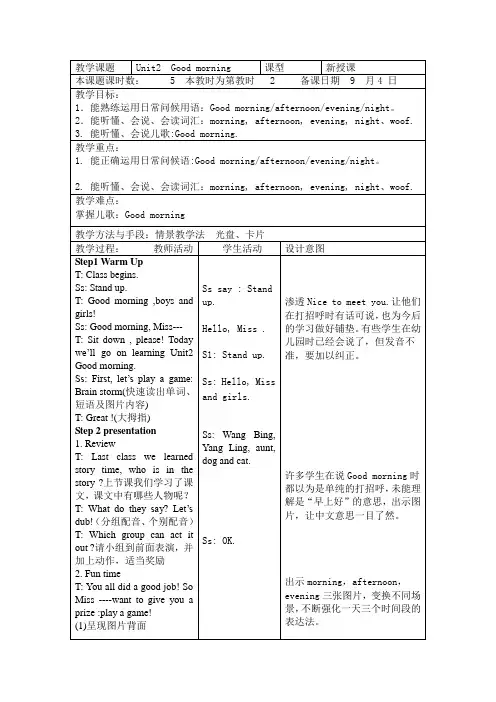
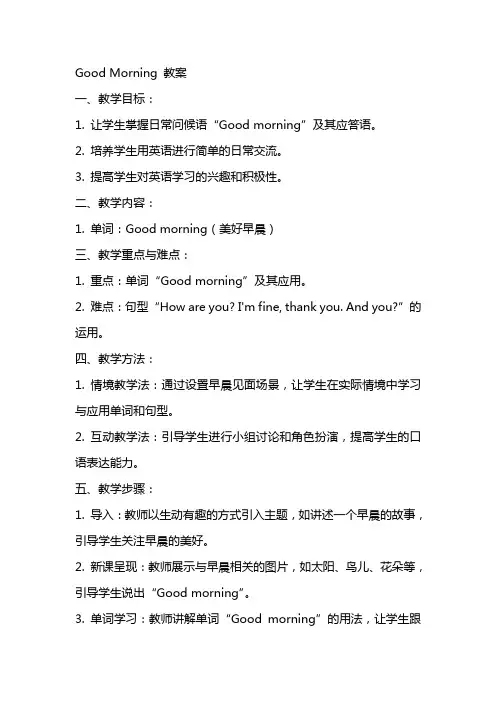
Good Morning 教案一、教学目标:1. 让学生掌握日常问候语“Good morning”及其应答语。
2. 培养学生用英语进行简单的日常交流。
3. 提高学生对英语学习的兴趣和积极性。
二、教学内容:1. 单词:Good morning(美好早晨)三、教学重点与难点:1. 重点:单词“Good morning”及其应用。
2. 难点:句型“How are you? I'm fine, thank you. And you?”的运用。
四、教学方法:1. 情境教学法:通过设置早晨见面场景,让学生在实际情境中学习与应用单词和句型。
2. 互动教学法:引导学生进行小组讨论和角色扮演,提高学生的口语表达能力。
五、教学步骤:1. 导入:教师以生动有趣的方式引入主题,如讲述一个早晨的故事,引导学生关注早晨的美好。
2. 新课呈现:教师展示与早晨相关的图片,如太阳、鸟儿、花朵等,引导学生说出“Good morning”。
3. 单词学习:教师讲解单词“Good morning”的用法,让学生跟读并模仿。
4. 句型学习:教师示范句型“How are you? I'm fine, thank you. And you?”的用法,让学生进行角色扮演,练习对话。
5. 小组活动:学生分成小组,用英语进行自我介绍,练习使用“Good morning”和句型“How are you? I'm fine, thank you. And you?”。
6. 课堂游戏:教师组织一个简单的游戏,如“Simon says”,让学生在游戏中运用所学知识。
7. 总结与作业:教师对本节课的内容进行总结,布置作业,要求学生复习单词和句型。
六、教学评估:1. 观察学生在课堂活动中的参与程度,掌握他们对单词“Good morning”和句型“How are you? I'm fine, thank you. And you?”的掌握情况。
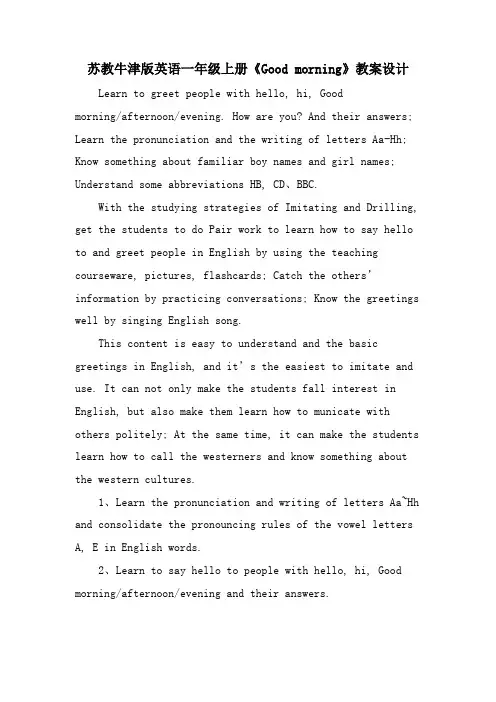
苏教牛津版英语一年级上册《Good morning》教案设计Learn to greet people with hello, hi, Goodmorning/afternoon/evening. How are you? And their answers; Learn the pronunciation and the writing of letters Aa-Hh; Know something about familiar boy names and girl names; Understand some abbreviations HB, CD、BBC.With the studying strategies of Imitating and Drilling, get the students to do Pair work to learn how to say hello to and greet people in English by using the teaching courseware, pictures, flashcards; Catch the other s’ information by practicing conversations; Know the greetings well by singing English song.This content is easy to understand and the basic greetings in English, and it’s the easiest to imitate and use. It can not only make the students fall interest in English, but also make them learn how to municate with others politely; At the same time, it can make the students learn how to call the westerners and know something about the western cultures.1、Learn the pronunciation and writing of letters Aa~Hh and consolidate the pronouncing rules of the vowel letters A, E in English words.2、Learn to say hello to people with hello, hi, Good morning/afternoon/evening and their answers.3、Learn to greet people with How are you? and their answers.Section A创设情境,导入新课Create plots and scenes to guide the new lessonThe main content of Section A is to learn to say helloto and greet to people by acting out the conversations and imitating them; Learn the pronunciation and writing ofletters Aa~Hh; Know something about familiar boy names and girl names. We can adopt the Situation Guiding Method andthe Audiovisual Guiding Method: The teacher can make a teaching courseware (about greeting) for the teaching, or prepare some cartoons to imitates the different voices of the people in the Cartoons to say hello to and greet each other, so the target sentences are guided Goodmorning/afternoon/evening, Helen! Goodmorning/afternoon/evening, Alice! Hi/Hello, Bob! Hi/Hello, Eric!; And then the teacher municates with the students; At last get the students to municate with each other.自读感知,整体把握Pre-read to apperceive and grasp the wholeSection A is designed by three steps. In 1a-1b, get the students to learn to say hello to and greet others by practicing conversations and know some cartoons well; In2a-3, get the students to learn the pronunciation andwriting of letters Aa-Hh and pay attention to the orders of strokes and formats, and get them to apperceive the pronouncing characters of letters A and E and concludetheir pronouncing rules; In 4a-4c, get them to grasp the familiar English names and consolidate the greetings.合作交流,解读探究Cooperate and intercourse to unscramble and researchThe main content in Section A is to learn the target language:Hi/Hello, Bob!Hi/Hello, Eric!Good morning/afternoon/evening, Helen!Good morning/afternoon/evening, Alice!【Intercourse】The teacher municates with the students in class first:(Say hello to the students)Hello, …!(Get the students to answer)Hel lo, …。
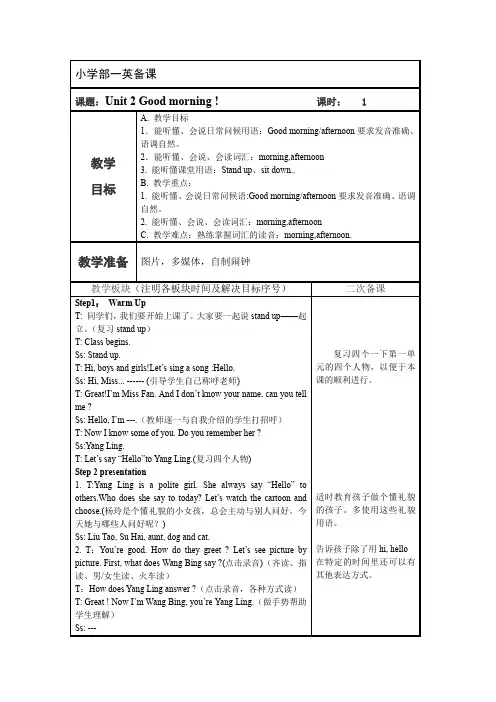
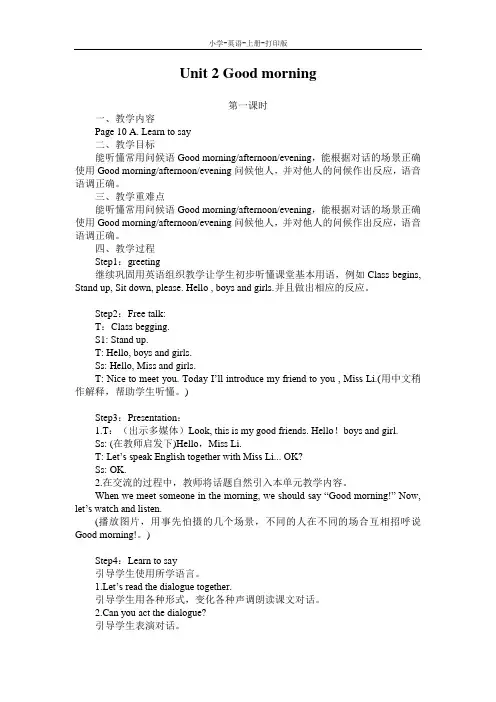
Unit 2 Good morning第一课时一、教学内容Page 10 A. Learn to say二、教学目标能听懂常用问候语Good morning/afternoon/evening,能根据对话的场景正确使用Good morning/afternoon/evening问候他人,并对他人的问候作出反应,语音语调正确。
三、教学重难点能听懂常用问候语Good morning/afternoon/evening,能根据对话的场景正确使用Good morning/afternoon/evening问候他人,并对他人的问候作出反应,语音语调正确。
四、教学过程Step1:greeting继续巩固用英语组织教学让学生初步听懂课堂基本用语,例如Class begins, Stand up, Sit down, please. Hello , boys and girls.并且做出相应的反应。
Step2:Free talk:T:Class begging.S1: Stand up.T: Hello, boys and girls.Ss: Hello, Miss and girls.T: Nice to meet you. Today I’ll introduce my friend to you , Miss Li.(用中文稍作解释,帮助学生听懂。
)Step3:Presentation:1.T:(出示多媒体)Look, this is my good friends. Hello!boys and girl.Ss: (在教师启发下)Hello,Miss Li.T: Let’s speak English together with Miss Li... OK?Ss: OK.2.在交流的过程中,教师将话题自然引入本单元教学内容。
When we meet someone in the morning, we should say “Good morning!” Now, let’s watch and listen.(播放图片,用事先怕摄的几个场景,不同的人在不同的场合互相招呼说Good morning!。
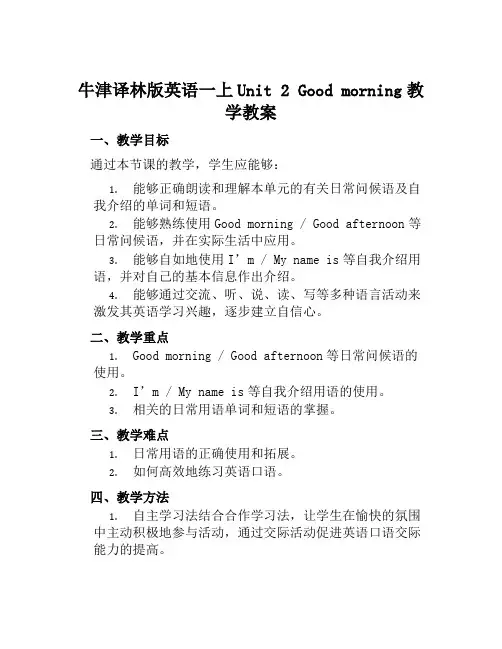
牛津译林版英语一上Unit 2 Good morning教学教案一、教学目标通过本节课的教学,学生应能够:1.能够正确朗读和理解本单元的有关日常问候语及自我介绍的单词和短语。
2.能够熟练使用Good morning / Good afternoon等日常问候语,并在实际生活中应用。
3.能够自如地使用I’m / My name is等自我介绍用语,并对自己的基本信息作出介绍。
4.能够通过交流、听、说、读、写等多种语言活动来激发其英语学习兴趣,逐步建立自信心。
二、教学重点1.Good morning / Good afternoon等日常问候语的使用。
2.I’m / My name is等自我介绍用语的使用。
3.相关的日常用语单词和短语的掌握。
三、教学难点1.日常用语的正确使用和拓展。
2.如何高效地练习英语口语。
四、教学方法1.自主学习法结合合作学习法,让学生在愉快的氛围中主动积极地参与活动,通过交际活动促进英语口语交际能力的提高。
2.情景交际法,利用真实情境,让学生在日常场景中积累实用英语语言知识和技能。
五、教学过程1. 热身(10分钟)1.教师通过多媒体让学生听好听写写单词和短语,检查对本单元单词和短语的掌握情况。
2.教师通过自我介绍示范学生如何准确、流畅地使用学过的日常用语。
2. 导入新课(10分钟)教师通过自己前期准备的情景,提供切入口,引导学生学习本课内容。
3. 讲解及练习(35分钟)教师通过展示PPT,向学生讲解Good morning / Good afternoon等日常问候语以及自我介绍用语等,然后通过特定情境的交际活动让学生互动口语练习,例如:1.第一环节场景:在医院门口碰见一位朋友,你应该怎么问候他?教师示范并提供Good morning / Good afternoon等日常问候语的用法,然后让学生成对练习,扮演顾客和服务员的角色,模拟对话。
2.第二环节场景:在规定的时间和场地进行自我介绍。
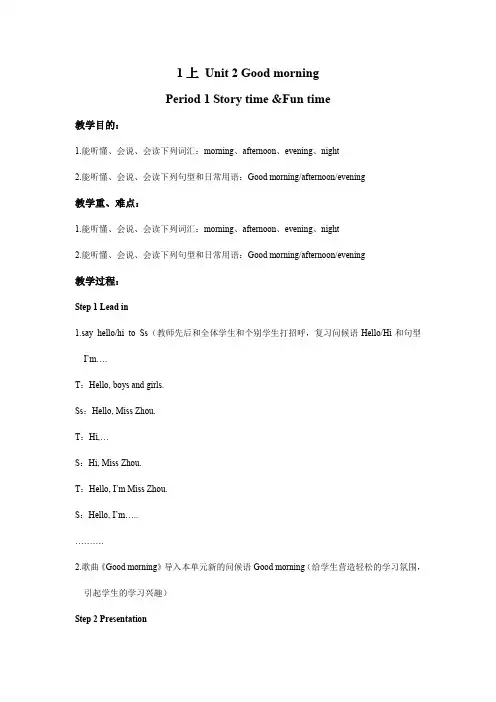
1上Unit 2 Good morningPeriod 1 Story time &Fun time教学目的:1.能听懂、会说、会读下列词汇:morning、afternoon、evening、night2.能听懂、会说、会读下列句型和日常用语:Good morning/afternoon/evening教学重、难点:1.能听懂、会说、会读下列词汇:morning、afternoon、evening、night2.能听懂、会说、会读下列句型和日常用语:Good morning/afternoon/evening教学过程:Step 1 Lead in1.say hello/hi to Ss(教师先后和全体学生和个别学生打招呼,复习问候语Hello/Hi和句型I’m….T:Hello, boys and girls.Ss:Hello, Miss Zhou.T:Hi,…S:Hi, Miss Zhou.T:Hello, I’m Miss Zhou.S:Hello, I’m…..……….2.歌曲《Good morning》导入本单元新的问候语Good morning(给学生营造轻松的学习氛围,引起学生的学习兴趣)Step 2 Presentation1.利用图片,教授目标词汇(教师呈现morning、afternoon、evening和night的图片,让学生注意图片中人物的活动和钟表显示的时间。
教师可以利用钟表呈现morning、afternoon、evening和night对应的时间段。
)morning :起床后至中午12点afternoon:中午12点至晚上6点evening:晚上6点到睡觉前night:和day 相对,指天黑或人们睡觉的时候,也用来指晚上睡觉前的一段时间2. read after the tape3.手偶游戏,呈现问候语good morning、good afternoon、good evening,教师用钟表显示不同的时间,然后根据时间显示,和手偶互致问候T:(将钟表指针指向9点)Good morning, Pat.P:Good morning ,Miss Zhou.T:(将指针指向12点半)Good afternoon, Pat.P:Good afternoon, Miss Zhou.T:(将指针指向7点)Good evening, Pat.P:Good evening, Miss Zhou.………Step 3 Practice1.师生问答,操练问候语Good morning/afternoon/evening(教师用钟表显示不同的时间,然后要求学生根据时间显示,向教师问候,学生先说,教师回应。
教学目标:知识能力与技能Learn to greet people with hello, hi, Good morning/afternoon/evening. How are you? And their answers; Learn the pronunciation and the writing of letters Aa-Hh; Know something about familiar boy names and girl names; Understand some abbreviations HB, CD、BBC. 过程与方法With the studying strategies of Imitating and Drilling, get the students to do Pair work to learn how to say hello to and greet people in English by using the teaching courseware, pictures, flashcards; Catch the others’ information by practicing conversations; Know the greetings well by singing English song. 情感、态度与价值观This content is easy to understand and the basic greetings in English, and it’s the easiest to imitate and use. It can not only make the students fall interest in English, but also make them learn how to communicate with others politely; At the same time, it can make the students learn how to call the westerners and know something about the western cultures. 重点难点:1、Learn the pronunciation and writing of letters Aa~Hh and consolidate the pronouncing rules of the vowel letters A, E in English words.2、Learn to say hello to people with hello, hi, Good morning/afternoon/evening and their answers. 3、Learn to greet people with How are you? and their answers. 教学过程:Section A 创设情境,导入新课Create plots and scenes to guide the new lesson The main content of Section A is to learn to say hello to and greet to people by acting out the conversations and imitating them; Learn the pronunciation and writing of letters Aa~Hh; Know something about familiar boy names and girl names. We can adopt the Situation Guiding Method and the Audiovisual Guiding Method: The teacher can make a teaching courseware (about greeting) for the teaching, or prepare some cartoons to imitates the different voices of the people in the Cartoons to say hello to and greet each other, so the target sentences are guided Good morning/afternoon/evening, Helen!Good morning/afternoon/evening,Alice! Hi/Hello, Bob! Hi/Hello, Eric!; And then the teacher communicates with the students; At last get the students to communicate with each other. 自读感知,整体把握Pre-read to apperceive and grasp the whole Section A is designed by three steps. In 1a-1b, get the students to learn to say hello to and greet others by practicing conversations and know some cartoons well; In 2a-3, get the students to learn the pronunciation and writing of letters Aa-Hh and pay attention to the orders of strokes and formats, and get them to apperceive the pronouncing characters of letters A and E and conclude their pronouncing rules; In 4a-4c, get them to grasp the familiar English names and consolidate the greetings. 合作交流,解读探究Cooperate and intercourse to unscramble and research The main content in Section A is to learn the target language: Hi/Hello, Bob!Hi/Hello, Eric!Good morning/afternoon/evening, Helen!Good morning/afternoon/evening, Alice!【Intercourse】The teacher communicates with the students in class first: (Say hello to the students)Hello, …!(Get the students to answer)Hello, …。
译林英语一上Unit 2 Good morning (Period 1)执教者:江建芬一、教学内容:Story time二、教学目标:1. 能听懂、会说、会读句型和日常用语:Good morning. Good afternoon. Good evening. Good night.能根据对话的场景正确使用,问候他人,并对他人的问候作出反应,语音语调正确。
2. 能听懂、会说、会读词汇:morning,afternoon.三、教学重难点1. 日常用语:Good morning/afternoon. 能根据对话的场景正确使用。
2. 词汇:morning,afternoon的读音。
四、教具、学具准备单词卡片,多媒体课件五、教学过程:Step1 GreetingsT:Class beings.Ss:Stand up.T: Hi, boys and girls.Ss: Hi, Miss Jiang.Step2 Presentation1. T: (shows the shadow of a c lock) Guess, what’s this?Listen, it’s a clock.展示钟。
T: Do you know what time is it?谁知道这是几点了?What shall we do?八点,早上八点。
Learn: morning.(m-or, n-ing, morning)2. T:in the morning, Ss should go to school.早上,同学们应该去上学了。
Let’s watch the cartoon.Who are they?Watch the picture 1.Check: Yang Ling and Wang Bing.3. T: how do they greet with each other? Hello? Hi?Watch again.Learn: good, good morning.开火车读同桌间互相读跨小组读。
Unit 2 Good morningthe first period一、教学内容Page 10 A.Learn to say二、教学目标能听懂常用问候语Good morning/afternoon/evening,能根据对话的场景正确使用Good morning/afternoon/evening问候他人,并对他人的问候作出反应,语音语调正确。
三、教学重难点能听懂常用问候语Good morning/afternoon/evening,能根据对话的场景正确使用Good morning/afternoon/evening问候他人,并对他人的问候作出反应,语音语调正确。
四、教学过程A. greeting继续巩固用英语组织教学让学生初步听懂课堂基本用语,例如Class begins, Stand up, Sit down, please. Hello , boys and girls.并且做出相应的反应。
B. Free talk:T:Class begings.S1: Stand up.T: Hello, boys and girls.Ss: Hello, Miss and girls.T: Nice to meet you. Today I’ll introduce my friend to you , Miss Li.(用中文稍作解释,帮助学生听懂。
)C、Presentation:(1)T:(出示多媒体)Look, this is my good friends. Hello!boys and girl.Ss: (在教师启发下)Hello,Miss Li.T: Let’s speak English together with Miss Li.. OK?Ss: OK.(2)在交流的过程中,教师将话题自然引入本单元教学内容。
When we meet someone in the morning, we should say “Good morning!” Now, let’s watch and listen.(播放图片,用事先怕摄的几个场景,不同的人在不同的场合互相招呼说Good morning!。
Unit2 Good morning 教学设计一、教学内容本单元的主要教学内容是“问候”。
用Good morning互问早安,是当今生活中极为常见的场景。
教师在教学中应尽可能地创设与实际生活相接近的各种场景,并结合本单元的afternoon, evening等单词,让学生在不同的情景中学习并使用日常问候语。
二、教学要求1.能听懂常用问候语Good morning/afternoon/evening.能根据对话的场景正确使用Good morning/afternoon/evening问候他人,并对他人的问候作出反应,语音语调正确。
2.能听懂、会说morning, afternoon, evening这三个单词,发音准确。
3.能根据对话场景,使用相应的句子主动问候他人,并作自我介绍。
4.能对他人的问候和自我介绍作出适当的回应,并作自我介绍。
5.会唱歌曲Good morning to you。
三、教科书教学建议建议在二至三课时内完成本单元的教学内容。
A Learn to say本部分的场景是孩子们在教室里上课,Miss Li站在讲台前,说: Good morning. Su Hai, Helen, Wang Bing和Mike正在教室上课,他们一起回答说: Good morning.教学时,建议采用如下步骤:1 引入话题1)教师可结合本单元的歌曲Good morning to you引人话题。
T: Now boys and girls, let’s listen to an En glish song. OK?(听歌曲)T: Do you like it?T: (指歌曲画面上的人物)Now, let’s say good morning to them.(带领学生一起说Good morning.)2)教师也可采用木偶表演的方式引入话题,如:T: Today my friend Joe is here again. Do you like him?Joe:(教师模仿小木偶的语气说)I like all of you, too. Good morning/afternoon, boys and girls.3)如有条件,教师可绘制简单的图片或制作幻灯,让学生明白morning一词的含义。
教学目标:知识能力与技能Learn to greet people with hello, hi, Good morning/afternoon/evening. How are you? And their answers; Learn the pronunciation and the writing of letters Aa-Hh; Know something about familiar boy names and girl names; Understand some abbreviations HB, CD、BBC.过程与方法With the studying strategies of Imitating and Drilling, get the students to do Pair work to learn how to say hello to and greet people in English by using the teaching courseware, pictures, flashcards; Catch the others’ information by practicing conversations; Know the greetings well by singing English song.情感、态度与价值观This content is easy to understand and the basic greetings in English, and it’s the easiest to imitate and use. It can not only make the students fall interest in English, but also make them learn how to communicate with others politely; At the same time, it can make the students learn how to call the westerners and know something about the western cultures.重点难点:1、Learn the pronunciation and writing of letters Aa~Hh and consolidate the pronouncing rules of the vowel letters A, E in Englishwords.2、Learn to say hello to people with hello, hi, Good morning/afternoon/evening and their answers.3、Learn to greet people with How are you? and their answers.教学过程:Section A创设情境,导入新课Create plots and scenes to guide the new lessonThe main content of Section A is to learn to say hello to and greet to people by acting out the conversations and imitating them; Learn the pronunciation and writing of letters Aa~Hh; Know something about familiar boy names and girl names. We can adopt the Situation Guiding Method and the Audiovisual Guiding Method: The teacher can make a teaching courseware (about greeting) for the teaching, or prepare some cartoons to imitates the different voices of the people in the Cartoons to say hello to and greet each other, so the target sentences are guided Good morning/afternoon/evening, Helen!Good morning/afternoon/evening, Alice! Hi/Hello, Bob! Hi/Hello, Eric!; And then the teacher communicates with the students; At last get the students to communicate with each other.自读感知,整体把握Pre-read to apperceive and grasp the wholeSection A is designed by three steps. In 1a-1b, get the students to learn to say hello to and greet others by practicing conversations andknow some cartoons well; In 2a-3, get the students to learn the pronunciation and writing of letters Aa-Hh and pay attention to the orders of strokes and formats, and get them to apperceive the pronouncing characters of letters A and E and conclude their pronouncing rules; In 4a-4c, get them to grasp the familiar English names and consolidate the greetings.合作交流,解读探究Cooperate and intercourse to unscramble and researchThe main content in Section A is to learn the target language:Hi/Hello, Bob!Hi/Hello, Eric!Good morning/afternoon/evening, Helen!Good morning/afternoon/evening, Alice!【Intercourse】The teacher communicates with the students in class first:(Say hello to the students)Hello, …!(Get the students to answer)Hello, …。
!(Say hello to the students)Hi, …!(Get the students to answer)Hi, …。
!(Say hello to the students)Good morning/afternoon/evening, …!(Get the students to answer)Good morning/afternoon/evening, …!【Experiences】After the students grasp the target sentences, the teacher projects the courseware (about greeting) or shows some cartoons and imitates different voices of the people in the cartoons (or play the tape)to say hello to and greet each other: Good morning/afternoon/evening, Helen!Good morning/afternoon/evening, Alice! Hi/Hello, Bob! Hi/Hello, Eric!; The students listen carefully while watching and grasp the pronunciation of some familiar English names, finish the teaching task of Activity 1b.【Activities】Get the students to practice conversations and communicate with each other. Get them to imitate the conversations they hear and say hello to and greet each other, finish the teaching task of Activity 1b.Hi/Hello, Bob!Hi/Hello, Eric!Good morning/afternoon/evening, Helen!Good morning/afternoon/evening, Alice!【Demonstration】Learn the pronunciation and writing of Englishletters Aa—Hh. The teacher can draw four-line grids on the blackboard and teach the students the correct writing orders and structures. The students imitate what the teacher have taught and pay attention to the varieties of capital and small English letters, finish the teaching task of Activities 2a and 2b.【Experiences】Play the tape of Activity 2c and get the students to listen and distinguish the right letters and mark the orders, finish the teaching task of Activities 2c.【Practice】Get the students to write the corresponding small letters according to the capital letters, finish the hearing teaching task of Activities 2d.【Discussion】Get the students to observe the abbreviations in Activity 3 and guess their meanings according to the pictures. Tell the students these abbreviations are common in English and also important, finish the teaching task of Activities 3.【Experiences】1)Play the tape of Activity 4a and get the students to listen and circle the names they hear according to the conversations, finish the hearing teaching task of Activities 4a.2)Play the tape of Activity 4a again and get the students to listen and match the conversations they hear with the pictures and mark the orders, finish the hearing teaching task of Activities 4b.【Activities】Get the students to drill the conversations in Activity 4b and grasp the target sentences: Good morning/afternoon/evening, Helen!Good morning/afternoon/evening, Alice!,finish the teaching task of Activity 4c.【要点直击】【English notes】中西方日常交际差异:中国人见面喜欢问:“你吃过了吗?”老外听了,以为你要请客;“你去哪儿?”老外认为你是干涉他的隐私。